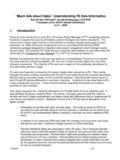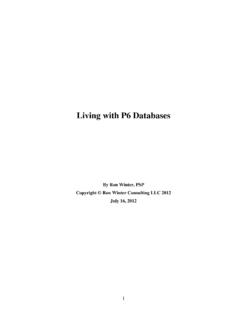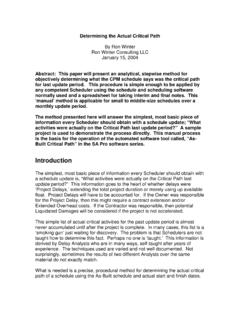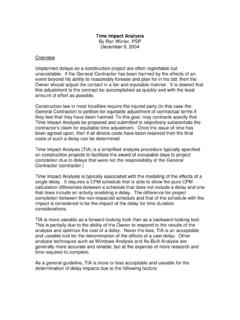Transcription of “Much Ado about Dates” Understanding P6 Date …
1 7/6/2009 1/21 much Ado about Dates Understanding P6 date information Ron Winter, PSP and F. Burak Evrenosoglu, CCE PSP Presented at the AACEi Annual Conference July 1, 2009 1. Introduction Since its initial introduction in early 80 s, Primavera Project Manager (P3 ) scheduling software has been a popular tool used by schedulers, project managers and claims consultants. The construction industry relies heavily on this software to develop, maintain and analyze project schedules. In 1999, Primavera introduced an entirely new Critical Path Method (CPM) scheduling package designed for enterprise-wide project management which changed names almost yearly. P3 remained P3 while this new enterprise-wide software is now called either P5 (short-hand for Primavera Project Manager ) or P6 (for Enterprise Version 6.)
2 Besides a fundamental shift in the way that dates are conceptualized, Primavera Inc s newest and most powerful scheduling software, P6, has more kinds of useable dates than any other software in existence. The majority of P6 users are unaware of the underlying calculations for new date fields and their usage. P3 users are frequently confused by the issue of dates when converting to P6. This is partly because the same company produces both P3 and P6 and partly due to the incorrect assumption that P3 must be an earlier version of the current P6 software. date fields with similar names in both P3 and P6 behave differently in one than in the other. A plethora of new date fields in P6 create a steep learning curve. A lack of documentation regarding these features creates a potential for real confusion.
3 This paper discusses the underlying calculations for P6 date fields and their potential uses. It also identifies the issues related to them. For brevity, this paper assumes that the reader is familiar with the P3 date characteristics and deals mainly with differences that an experienced P3 user would understand or expect. Highlights of some of the P6 date issues discussed in this paper include: o Schedulers are familiar with early and late dates. The whole purpose of CPM is to calculate the early and late dates so that the criticality of activities can be determined. P6 and P3 use fundamentally different method to calculate and store traditional CPM dates. o In addition to the traditional CPM date fields, P6 contains numerous other date fields that are not included in traditional college courses on CPM scheduling.
4 O Planned start/finish dates are confusing to many P6 users. This is because planned dates are neither static like baseline dates nor dynamic like early and late dates once the activity has progressed. Planned dates might end up being your baseline dates, and yet they are not truly a baseline. Planned dates do not always display planned information . In some instances they display budgeted and current information as well. So the question becomes, how do the planned start/planned finish dates come into play for you as a project manager? 7/6/2009 2/21 o Many P6 users are puzzled to see complete activities where early and late dates differ from actual dates. Does that mean P6 calculates early and late dates for complete activities? If so, total float for complete activities can be calculated.
5 Is this as-built float? So how do the early/late dates come into play for you as a claims consultant? o P6 introduced a new float field called remaining float which is dependant on resource leveling. So how does remaining float come into play for you as an earned value professional or as a scheduler? Flexibility and abundance of date fields can be a benefit to the scheduler in developing the work plan if the scheduler is aware of the underlying calculations and uses them purposefully. Similarly, claims consultants must understand the P6 date fields so that they can analyze clients schedules in their original format, without converting to P3. 2. The date Fields The first step in Understanding P6 date fields is to realize the scope and variety of date fields.
6 One logical way of categorizing the date fields is by functional hierarchy. date fields can be categorized into 5 main groups: 1. Project date Fields 2. WBS date Fields 3. Activity date Fields 4. Resource date Fields 5. Relationship date Fields A list of the P6 date fields are shown below in Table 1. Project & WBS date Fields Anticipated Start Anticipated Finish Actual Start Actual Finish Planned Start Finish date Forecast Start Forecast Finish Must Finish By Activity date Fields Start Finish Early Start Early Finish Planned Start Planned Finish Remaining Early Start Remaining Early Finish Remaining Late Start Remaining Late Finish Actual Start Actual Finish External Early Start External Late Finish Baseline Start Dates Baseline Finish Dates Variance BL1 Start date Variance BL1 Finish date Primary & Secondary Constraint Dates Expected Finish date 7/6/2009 3/21 Resource date Fields Start Finish Actual Start Actual Finish Planned Start Planned Finish Remaining Early Start Remaining Early Finish Remaining Late Start Remaining
7 Late Finish Relationship date Fields Relationship Early Start Relationship Early Finish Relationship Late Start Relationship Late Finish Audit date Fields (per record for Project/Activity/Step/Activity Code/Relationship/Expense) date Created date Last Updated date Deleted Table 1 date Fields in P6 Activity and resource dates are the main focus of this paper. When we refer to an activity date field, we mean that every activity in the schedule has a slot available for storing the particular date that applies just to that activity. P6 has storage set aside to hold a unique date from every one of the above fields for every activity in the schedule. A brief introduction to project & WBS dates is appropriate since project & WBS dates, such as the Planned Start and the Must Finish By, affect the activity-level calculations.
8 Planned Start date field is the start date of the project. No early dates will be calculated before this date . Must Finish By date field is a date constraint placed on the project completion. Must Finish By date determines the late finish of the first activity in the backward pass. Very little is known for certain about Forecast Start and Finish dates. The documentation suggests that they play a part in resource leveling. They become the end points of the forward and backward resource leveling process. It is possible that this feature only applies to the web version of P6. Finish date is the latest early finish date calculated when P6 last scheduled the project. Actual Start is the actual start date of the project, and it is inherited from the first started activity.
9 Similarly, Actual Finish date is inherited from the last completed activity. Anticipated Start / Finish date fields are used during the project planning stage, and can be set at the Enterprise Project Structure (EPS), project, or WBS level. These dates are displayed at EPS level bars and columns when there are no activities. These dates remain as historical record when activities are added. 3. How Does P6 Calculate date Fields? One of the greatest differences between P3 and P6 software is how they deal with dates. Users of P3 decide upon the unit of measure before they create a new schedule. You can pick months, weeks, days, or hours. After the schedule is created, the chosen unit of measure is forever fixed and indivisible. Most construction projects are scheduled in days.
10 This unit of measure is normally appropriate for planning, estimating, and measurement. Appropriate unit granularity is enforced by an engineering assumption that all work begins at the beginning of the work day and all work finishes 7/6/2009 4/21 at the end of the work day. P3 has no provision for measuring durations less than the chosen unit of measure. The point here is that the engineers who designed P3 were forced to consider significant accuracy. You started with days and every mathematical calculation had to return whole number of days. As an example, if you were to status a 6-day activity as 30% complete, that would mean that you had 4 days remaining, not the days that the mathematical calculation would suggest. Engineers would say that if we plan our work using whole days and measure it in whole days, then it is false accuracy to say we can predict anything with better accuracy than a full day s duration.






